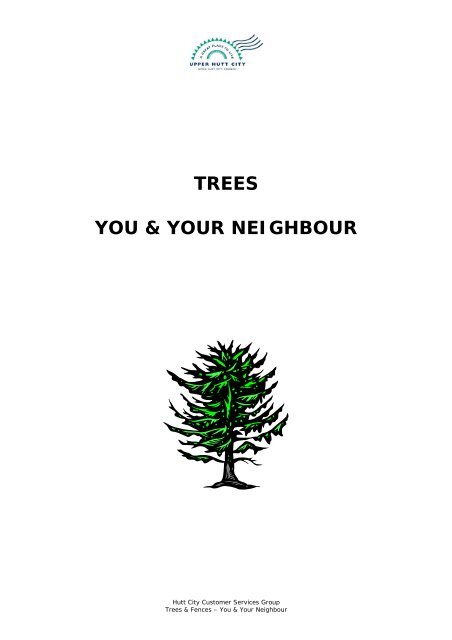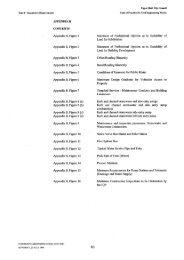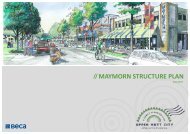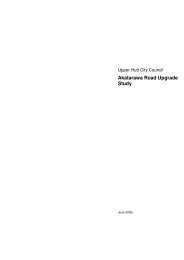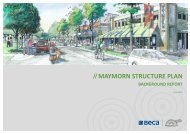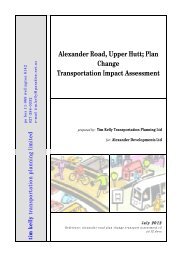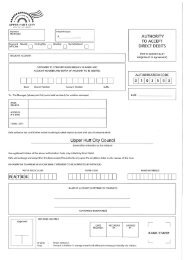TREES YOU & YOUR NEIGHBOUR - Upper Hutt City Council
TREES YOU & YOUR NEIGHBOUR - Upper Hutt City Council
TREES YOU & YOUR NEIGHBOUR - Upper Hutt City Council
Create successful ePaper yourself
Turn your PDF publications into a flip-book with our unique Google optimized e-Paper software.
tree removed. They are not prepared to do that. You decide to solve the problemby poisoning the roots on your side of the fence. Unfortunately the poison killsthe tree and your neighbour threatens to take you to court for damaging theirproperty. Can they do this?Yes – the proper thing to do would have been to dig up and cut off the roots onyour side of the boundary, or to take court action, rather than use poison thatwould lead to the death of the tree. You are allowed to remove any part of aneighbour’s property that intrudes into your property but your right to take actionstops at the boundary line between your property and your neighbour’s. Usingpoison that would have an effect beyond your side of the boundary is illegal.LeavesA neighbour’s oak tree continually drops leaves in the guttering of your house,forcing you to climb a ladder every few weeks to get the leaves out. Do you haveto suffer this inconvenience?If the branches causing the problem are growing over your side of the fence, youare allowed to prune them back to the boundary. If not, you can ask yourneighbour to cut back the trees or remove them. If the neighbour disagrees, youcould try and get a court order to solve the problem.A large conifer growing on the other side of your back fence is obviously dying.You are concerned that at any time the tree, or part of it, could fall on yourhouse. You ask your neighbour to do something about it. They tell you to mindyour own business as the tree is doing no harm and in their opinion is unlikely tofall down on you or your house. But you are not convinced. Can you have the treechopped down?Yes, but first you must apply for a court order to have the tree removed. If youcourt agrees that the tree is likely to damage your house or cause a danger toanybody, the neighbour will have no choice but to cut it down once the order ismade.BranchesYou buy a section. There is a large chestnut tree growing on the property nextdoor, with branches growing over your side of the boundary fence. The law allowsyou to cut off the branches on your side, but they are long and thick, making it amajor operation. Is your neighbour obliged to do the work or pay for it to bedone?No. Provided the branches are not causing any real nuisance, they are yourresponsibility if they are growing on your side of the fence.You remove a large branch from a neighbour’s plum tree that is growing overyour property. This is quite legal but unfortunately the result of this “amputation”is that the neighbour’s tree dies. Can you neighbour demand compensation?No, you were within your rights when you cut off the branch on your side of theboundary, as long as the method you used was reasonable. It might be that anyresulting damage to the tree was the neighbour’s fault anyway, because theyshould have pruned the branch back when the tree was young (so that the life ofthe tree was less likely to be affected).If the branches of your neighbour’s tree encroach on your land (or the roots arecausing a nuisance), you can cut them back to the boundary line. In law this iscalled “abatement.” But unless you have your neighbour’s permission, you cannotthin the whole tree yourself, trespass on your neighbour’s property or chop downa tree growing on the boundary without an order from the court.Page 3 of 4
Remember that the parts of the tree removed (including any fruit) belong to yourneighbour even if they hang or fall over your property.If you need advice, ask an independent arboriculturist (a “tree doctor”) for anassessment – some will provide this advice free if they are likely to get the work.If you don’t want to trim the branches yourself, or cannot reach agreement withyour neighbour, you will need to get an order from the District Court for the treeto be trimmed or removed.SunlightTrees on a neighbour’s property are blocking sunlight from your house andgarden. Is this a good enough reason to ask that they be cut back?Yes. Talk to your neighbour and try and find a solution both you can live with –does the tree really need to be chopped down? Could it be thinned? A mutuallyagreed solution is always preferable to a lengthy, costly and potentially bitterlegal battle.ViewsWhen you bought your home 10 years ago, you had a great view from yourlounge window. Now a line of trees has grown high enough to block your viewcompletely.The trees are not on your immediate neighbour’s property but on property furtherdown the street. Can you do anything about having them cut back?It does not matter if the trees are on a neighbour’s property or one further away.First, you should try approaching the owner of the property where they aregrowing – they may agree to trim the tops of the trees. If not, you will need toseek legal advice about taking the case to court to try and get an order –remember, this may be costly, and you may not win.FruitFruit trees growing on your property branch out over your neighbour’s. Theneighbour picks all the fruit growing on their side of the fence – can you doanything about it?Yes. A neighbour must not take your property, even if the branches are hangingwell over your neighbour’s section. The fruit on them still belongs to you.However, the neighbour could exercise their right to cut off the branches whichare “intruding” on to their property. Try working out a compromise with yourneighbour.Who pays?If you have roots or branches cut back on your side of the boundary, you willprobably have to pay. If you have applied for a court order, the presumption isthat you will pay for the work to be done, although the court is able to make theother party pay if this is fair.However, if the tree does damage to your property, the neighbour may have topay – both for cleaning up the mess and making good on the damage. This is trueeven if the damage is caused by something by something beyond their controlsuch as a storm, but only if they should have known their tree was unsafe andthey had the opportunity to make it safe but had chosen to do nothing about it.Page 4 of 4


